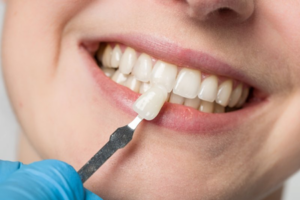Dental Veneers Through the Decades: A Look into How This Cosmetic Has Improved Over the Years
October 28, 2025

The dental veneers you know today are seamless cosmetics that can last for up to 15 years or more, but they weren’t always like that! It took time and effort to perfect the treatment process. In fact, dental veneers have changed quite a bit since they were first created by Charles Pincus in the 1920’s. Keep reading to see just how much they’ve improved through the decades.
1920s: Glamorous but Temporary
As hinted at above, dental veneers were invented by Dr. Charles Pincus. Pincus, though, was a dentist with a very unique and specific clientele: movie stars. That’s right – Pincus was favored by the actors and actresses performing in this quickly blossoming industry, and he saw a need. Not everyone had a flawless smile, which could be an aesthetic problem when the camera zoomed-in for a closeup.
To fill this need, Dr. Pincus developed smooth shells that could be quickly attached to a star’s teeth. Make no mistake, these early veneers got the job done – but they only lasted for hours at most, making them rather impractical for anything other than showbiz.
1950s: Forging Stronger Bonds
Some 30 years later, that problem would be solved by Dr. Michael Buonocore. Or at least, he would pave the way for more reliable, longer-lasting veneers in the future. You see, Dr. Buonocore discovered that certain chemicals effectively created small pours on the surface of dental enamel without damaging the tooth’s structure. This new texture enabled dental bonding and restorations to grip the tooth more firmly.
The process of applying these chemicals is known as “etching,” and even though Dr. Buonocore focused on restorative dentistry, it wouldn’t take long for others to realize it could benefit dental cosmetics as well.
1980s: Perfecting the Technique
In 1982, Drs. Simonsen and Calamia took Buonocore’s etching technique and modified it ever-so-slightly. By incorporating hydrofluoric acid as an adhesive compound, they could provide patients with veneers that lasted years longer than what was previously possible. After documenting their work, dental veneers became a more accessible option for more people. Etching with hydrofluoric acid is still how dentists bond veneers to teeth today.
Can you imagine investing in dental cosmetics that would only stay on your teeth for a couple of hours? Thanks to the improvements made by these dentists over the decades, you don’t have to. Rest assured, modern veneers are better and more cost-effective than ever before!
About the Practice
Our dental team at the Center For Advanced Cosmetic Dentistry is passionate about helping patients feel more confident in their smiles. As proud members of the American Academy of Cosmetic Dentistry, Dr. Crescenzo and Dr. Montalbano are particularly skilled at designing stunning veneers for those wanting to conceal their dental flaws. To schedule your dental veneer treatment today, contact our office at 609-561-0058.
